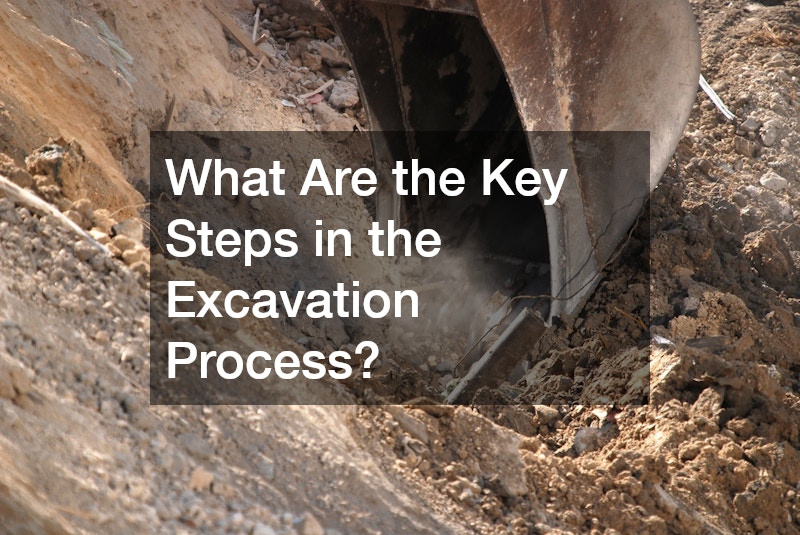Excavation is a fundamental part of most construction and infrastructure projects. Whether it’s for residential foundations, commercial developments or large-scale civil engineering works, excavation lays the groundwork for everything that follows.
Without precise and well-planned excavation, the structural integrity and longevity of a building or system may be compromised. Understanding the key steps in this process is essential not only for industry professionals but also for property owners and project managers overseeing construction efforts.
Planning & Site Evaluation
Every excavation project begins with meticulous planning and thorough site evaluation. Before any soil is moved, construction teams must assess the land to understand its topography, soil composition and environmental conditions. This often involves surveying the area using modern equipment such as GPS and laser technology to create a detailed map of the site. Environmental impact studies may also be conducted, especially if the project is near sensitive ecosystems or heritage-listed areas.
Engineers and geotechnical experts review the collected data to identify potential challenges such as underground water, rock layers or contaminated soil. These findings inform decisions about the appropriate machinery, safety precautions and excavation techniques to use. Additionally, plans must comply with local regulations, council approvals and building codes. Any failure to meet these requirements can lead to project delays, fines or even complete shutdowns. The planning phase is crucial because it minimises risk, ensures compliance and helps the team work more efficiently throughout the excavation.
Clearing & Marking the Site
Once the plan is in place, the next step is to prepare the site for excavation. This typically involves clearing the area of vegetation, debris and any existing structures that may interfere with the dig. Trees may be removed, ground cover stripped back and any hazardous materials safely disposed of. Following this, the site is marked according to the approved designs, outlining where excavation will occur. This can include spray painting, flagging or using stakes and string lines to show cut lines, boundaries and levels.
This phase may seem straightforward, but it is a vital step that ensures the excavation remains within its designated area. Precise markings reduce the risk of over-excavating or interfering with nearby infrastructure such as utilities, roads or neighbouring properties. Dial Before You Dig services are also contacted to identify and locate underground cables, pipes or sewer lines to prevent accidental damage and service disruption.
Excavation & Soil Removal
The actual excavation process involves removing earth, rock and other materials to the desired depth and contour. Depending on the project’s complexity, this might be done using hand tools, excavators, bulldozers or other specialised machinery. The goal is to create a stable and level foundation that matches the engineering specifications outlined in the planning stage.
Excavation can involve different techniques depending on the purpose and ground conditions. For example, trenching is used for laying utilities like water pipes or cables, while bulk excavation removes large volumes of material for basements, roads or dam construction. Throughout this stage, constant measurements are taken to ensure accuracy. Laser levels, total stations and GPS systems guide operators in achieving correct depths and slopes.
Excavated material is either reused on-site for backfilling and landscaping or removed and transported to approved disposal sites. Soil management is essential, particularly when dealing with contaminated earth or when meeting sustainability targets through material recycling. Good practice in excavation ensures minimal environmental disruption and efficient use of resources.
Shoring, Drainage & Safety Measures
As excavation progresses, safety and stability become top priorities. In deeper or unstable digs, shoring systems such as retaining walls, sheet piling or trench boxes are installed to prevent cave-ins and ensure worker protection. Water control measures are also introduced to manage groundwater or rain runoff. Without proper drainage, excavated sites can flood, delay construction and pose health and safety hazards.
In commercial and infrastructure projects, temporary access roads, ramps and barriers are established to support machinery movement and protect nearby structures. Regular inspections are conducted to check for signs of soil movement, water ingress or structural stress. Adherence to workplace health and safety standards is non-negotiable during excavation. Protective gear, traffic control and emergency response protocols are all implemented to ensure that everyone on-site operates in a secure environment.
Final Grading & Site Preparation
Once the necessary depth and shape are achieved, the excavation process transitions into final grading and site preparation. This involves smoothing out the base and ensuring the surface meets precise engineering tolerances. Compaction equipment is used to compress the soil, reducing the risk of settling that could lead to foundation issues later.
In some cases, further stabilisation may be required through the addition of gravel, sand or engineered fill. The finished excavated area is inspected for quality assurance and any deficiencies are corrected before construction proceeds. Accurate grading also facilitates proper drainage and ensures structural alignment for the next phase of the build.
Excavation is much more than digging a hole; it’s a coordinated process involving planning, precision and safety. With experienced professionals, the right equipment and adherence to safety protocols, excavation can be carried out smoothly and efficiently, setting the stage for a structurally sound and long-lasting build. If you’re beginning a construction project and want expert excavation work, consult a licensed contractor with proven experience to ensure your site is prepared to the highest standard.




